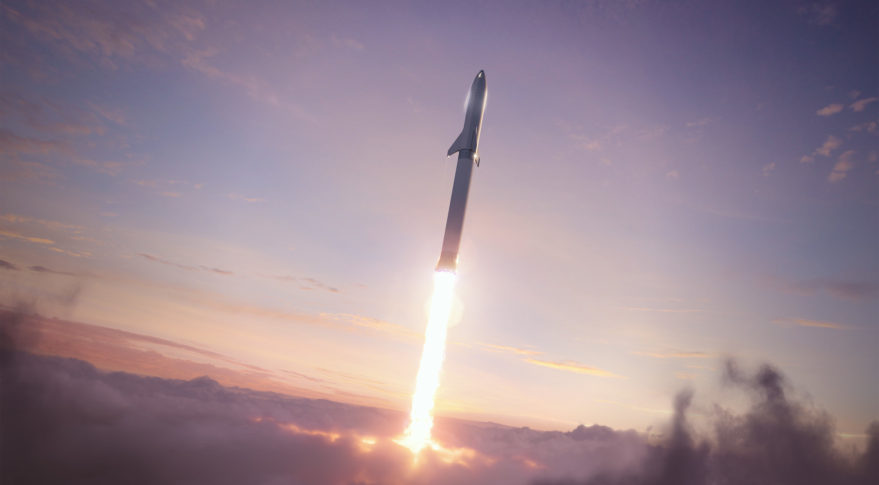SpaceX Targets 2021 Commercial Starship Launch

JAKARTA, Indonesia — The first commercial mission for SpaceX's Starship and Super Heavy launch system will likely take place in 2021, a company executive said June 26.
Jonathan Hofeller, SpaceX's vice president of commercial sales, said the company is in talks with prospective customers for the first commercial launch of that system roughly two years from now.
"We are in discussions with three different customers as we speak right now to be that first mission," Hofeller said at the APSAT conference here. "Those are all telecom companies."
Related: SpaceX's 'Starship' Prototype Coming Together in Florida (Photos)
SpaceX's Super Heavy booster and Starship upper stage are being designed to launch up to 20 metric tons to geostationary transfer orbit, Hofeller said, or more than 100 metric tons to low Earth orbit. Equipped with a nine-meter payload fairing, the launch system is designed to carry crew and resources to the moon and Mars, but is also SpaceX's next vehicle to send satellites into orbit around the Earth and elsewhere.
Hofeller said SpaceX plans to do several test flights before using the next-generation launch system for satellites. Those test flights — a number he did not quantify — are to demonstrate the launch system for customers and to assuage any concerns by insurers about the reliability of a new vehicle.
SpaceX performed a "hop" with a prototype of Starship in April, propelling the vehicle just centimeters off the ground, Hofeller said. Future tests will reach higher altitudes, he said.
Breaking space news, the latest updates on rocket launches, skywatching events and more!
"We have future hops coming up later this year," he said. "The goal is to get orbital as quickly as possible, potentially even this year, with the full stack operational by the end of next year and then customers in early 2021."
SpaceX ultimately intends to supersede its current partly reusable Falcon 9 and Falcon Heavy launchers with the fully reusable Super Heavy booster and Starship upper stage. The company won't rush customers from one generation of vehicles to another, however.
"Falcon 9 and Falcon Heavy are going to be around as long as our customers want them," Hofeller said. "If we make them obsolete by having a better product and a lower price, great."
Hofeller said the discounted pricing SpaceX gave to early customers of Falcon 9 missions with pre-flown first-stage boosters is now the company's normal pricing. SpaceX Founder Elon Musk said last year that previously flown booster missions were priced "around $50 million," down from $62 million. Musk said SpaceX's prices would continue to decline, too.
Hofeller reiterated that prices would keep dropping through the introduction of Super Heavy and Starship. The fully reusable nature of the launch system enables those lower prices, he said.
Being fully reusable also opens up new mission possibilities, he said.
"You could potentially recapture a satellite and bring it down if you wanted to," Hofeller said. "It's very similar to the [space] shuttle bay in that regard. So we have this tool, and we are challenging the industry: what would you do with it?"
SpaceX explored making the Falcon 9 fully reusable, but struggled with decelerating the upper stage, Hofeller said. Efforts to slow the upper stage would have drained energy otherwise used to carry a payload, he said.
SpaceX has reused a single Falcon 9 first-stage booster up to three times to date. The block 5 version of the rocket, which debuted last year, is designed for up to 10 launches without major refurbishment.
Hofeller said SpaceX plans to reuse a single Falcon 9 booster five times by the end of this year.
- Read SpaceNews for the Latest Space Industry News
- SpaceX's 'Starhopper' Starship Prototype Just Aced Its 1st Hop, Elon Musk Says
- SpaceX Finishes Building 'Starship' Hopper Prototype (Photo)
This story was provided by SpaceNews, dedicated to covering all aspects of the space industry.
Caleb Henry is a senior analyst for Quilty Analytics and a former staff writer for the space industry publication SpaceNews. From 2016 to 2020, Caleb covered the global satellite industry for SpaceNews, chronicling everything from launches, spacecraft manufacturing and ground infrastructure. Caleb's work has also appeared in NewSpace Global and Access Intelligence. He earned a bachelor's degree in political science with a minor in astronomy from Grove City College.

